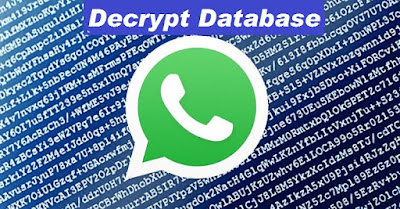WhatsApp backup conversation files are now saved with the
.crypt12 extension. From crypt9, they seem to be using a modified version of Spongy Castle – a cryptography API library for Android. |
| Decrypt Database |
All the findings below are based on reverse engineering work done on WhatCrypt and Omni-Crypt. I would like to highlight that IGLogger proved to be a very useful tool when it came to
smali code debugging.Extract Key File
To decrypt the
crypt12 files, you will first need the key file. The key file stores the encryption key, K. WhatsApp stores the key file in a secure location: /data/data/com.whatsapp/files/key.
If your phone is rooted, extracting this file is easy. If your phone is not rooted, refer to instructions from WhatCrypt and Omni-Crypt for details on extracting the
key file. The idea is to install an older version of WhatsApp, where Android ADB backup was still working and extract the key file from the backup.Extract crypt12 Backup File
Pull the encrypted WhatsApp messages file from your phone using ADB.
$ adb pull /sdcard/WhatsApp/Databases/msgstore.db.crypt12
Decryption Keys
This section is just for your information and you can skip this section.
The encryption method being used is AES with a key (
K) length of 256 bits and an initialisation vector (IV) size of 128 bits. The 256-bit AES key is saved from offset 0x7E till 0x9D in the file. Offsets start from 0x00. You can extract the AES key with hexdump and assign the value to variable $k.$ k=$(hexdump -ve '2/1 "%02x"' key | cut -b 253-316)
The
$k variable will hold a 64-digit hexadecimal value in ASCII that is actually 256 bits in length.
The IV or the initialisation vector is saved from offset 0x33 till 0x42 in the
crypt12 file. The IV value will be different for every crypt12 file.$ iv=$(hexdump -n 67 -ve '2/1 "%02x"' msgstore.db.crypt12 | cut -b 103-134)
The
K and IV extraction method is similar to what we have done for crypt8 files before.Strip Header / Footer in crypt12 File
Again, this section is just for your information and you can skip this section.
Before we start the decryption process, we will need to strip the 67 byte header and 20 byte footer from the
crypt12 file.$ dd if=msgstore.db.crypt12 of=msgstore.db.crypt12.enc ibs=67 skip=1 $ truncate -s -20 msgstore.db.crypt12.enc
The above
dd command will strip the the first 67 bytes from the crypt12 file and save it to a file with extension crypt12.enc. The truncate command will strip the last 20 bytes from the crypt12 file.Decrypt crypt12 File
As the WhatsApp AES cryptography API library seems to be a modified version, we will no longer be able to use
openssl to decrypt the crypt12 file. I have yet to determine what has been modified.
To decrypt
crypt12 files, I have written a simple Java program that will use the modified cryptography API library instead. For the cryptography API library, I have extracted the modified Spongy Castle cryptography class files from the Omni-Crypt APK file using dex2jar. You can find the Java program and crypto library over here at GitLab.
The Java program will create 3 output files:
msgstore.db.crypt12.enc– encrypted file with header and footer stripped.msgstore.db.zlib– decrypted file in zlib format.msgstore.db– decrypted sqlite3 database file.
Below is how you can compile and run the Java program.
$ git clone https://gitlab.com/stackpointer/whatsapp-crypt12.git $ cd whatsapp-crypt12/ $ javac -classpath "lib/whatsapp_spongycastle.jar:." crypt12.java $ cp ../whatsapp.data/key . $ cp ../whatsapp.data/msgstore.db.crypt12 . $ java -cp "lib/whatsapp_spongycastle.jar:." crypt12 K:XXXXXXXXXX IV:YYYY creating encrypted file with header/footer stripped: msgstore.db.crypt12.enc creating zlib output file: msgstore.db.zlib creating sqlite3 output file: msgstore.db $ ls -l total 136724 -rw-r--r-- 1 ibrahim staff 4339 Oct 9 16:05 crypt12.class -rw-r--r-- 1 ibrahim staff 5459 Oct 9 16:05 crypt12.java -rw-r--r-- 1 ibrahim staff 158 Oct 9 16:05 key drwxr-xr-x 2 ibrahim staff 4096 Oct 9 16:05 lib -rw-r--r-- 1 ibrahim staff 1089 Oct 9 16:05 LICENSE -rw-r--r-- 1 ibrahim staff 62692352 Oct 9 16:06 msgstore.db -rw-r--r-- 1 ibrahim staff 25757610 Oct 9 16:05 msgstore.db.crypt12 -rw-r--r-- 1 ibrahim staff 25757523 Oct 9 16:05 msgstore.db.crypt12.enc -rw-r--r-- 1 ibrahim staff 25757507 Oct 9 16:06 msgstore.db.zlib -rw-r--r-- 1 ibrahim staff 1376 Oct 9 16:05 README.md $ file * crypt12.class: compiled Java class data, version 52.0 (Java 1.8) crypt12.java: C source, ASCII text key: Java serialization data, version 5 lib: directory msgstore.db: SQLite 3.x database, user version 1 msgstore.db.crypt12: raw G3 data, byte-padded msgstore.db.crypt12.enc: data msgstore.db.zlib: zlib compressed data
Final Words
To use the Java decryption tool, you will need to use OpenJDK. Oracle require JCE Provider libraries to be signed. OpenJDK does not have this requirement. If you try running the Java program on Oracle JDK, you will most likely get the following exception.
Exception in thread "main" java.lang.SecurityException: JCE cannot authenticate the provider SC




